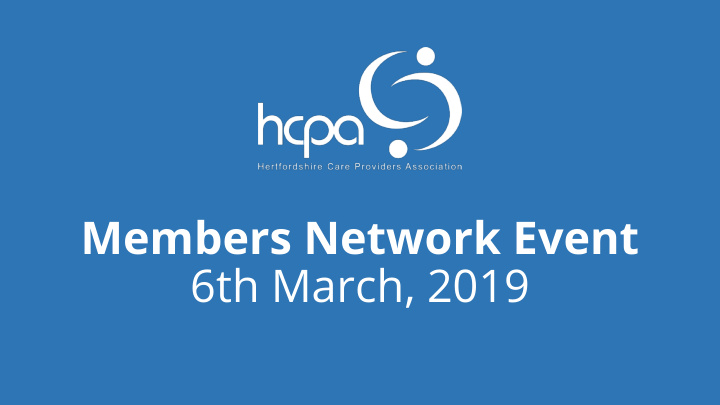



Members Network Event 6th March, 2019
Older People Support Services* Draft Exercise standards • Active Ageing • AGENDA Exercise and Education • Best Practice Falls Pathways • Malnutrition and Dehydration • Enablement and Postural Support •
Exercise Standards Current guidelines from NICE 1.1.5 Exercise in extended care settings 1.1.5.1 Multifactorial interventions with an exercise component are recommended for older people in extended care settings who are at risk of falling. [2004] National Institute for Health and Care Excellence. (2013). Falls in older people: assessing risk and prevention . NICE.
1- What are you currently offering within your service? 2- What areas would you like more support and guidance? 3- Any other feedback on the standards?
HCPA Offer • Chair Based Exercise level 2 • Developing a Level 3 Balance course • Physio Support Facilitator Long term (10 month) Exercise group 6 sites – Care home CBE 4 Sites – Care Homes Dementia 10 Sites Flexi / Supported living 5 Intergenerational exercise groups
HCPA Offer • Chair Based Exercise level 2 • Developing a Level 3 Balance course • Physio Support Facilitator Long term (10 month) Exercise group 5 Learning Disability services
Falls Pathways ● Falls Risk Identification ● Management of person who has fallen - Care Home and Domiciliary
FRAT
Falls Checklist
Malnutrition and Dehydration – Care Homes and Homecare Alison Smith Prescribing Support Consultant Dietitian Herts Valleys Clinical Commissioning Group
Hydration Dehydration in older people is common too Also affects most body systems Unlike malnutrition, there is no validated screening tool
What does CQC say? A variety of nutritious, appetising food should be available to meet people's needs and be served at an appropriate temperature. When the person lacks capacity, they must have prompts, encouragement and help to eat as appropriate. Where a person is assessed as needing a specific diet, this must be provided in line with that assessment Staff must follow the most up-to-date nutrition and hydration assessment for each person and take appropriate action if people are not eating and drinking in line with their assessed needs Staff should know how to determine whether specialist nutritional advice is required and how to access and follow it
What do the CCGs (NHS) advise in Herts? Raise awareness about malnutrition Identify malnutrition before you start to treat it Follow Herts guidance when treating malnutrition
New – Herts Malnutrition management pathway for care homes
Nutrition policies What does yours say? Potential for Herts wide care home nutrition policy
Treating malnutrition – Hospital vs community Many patients receive sip feeds during a hospital admission In hospital, sip feeds are likely to be the most cost effective way of preventing and treating malnutrition Sip feeds are often included on discharge summaries, but usually they are not needed following discharge because : • • When in hospital most patients are: On discharge home most patients: • • acutely unwell, which increases are no longer as acutely unwell • nutritional requirements but have an improved appetite and decreases nutritional intake can choose familiar and preferred • in an unfamiliar environment, meals/ snacks at times and in an offered unfamiliar food which environment that suit them • they may not find appetising, at can implement a food first times which may not suit them approach (especially true for those resident in a care home)
Treating malnutrition – ONS vs homemade suppleme nts 1 bottle of Ensure Plus provides 330kcal + 13.8g protein; cost to the NHS = £1.11 1 over the counter Complan provides 387kcal + 15.6g protein; cost to the patient/Home = £0.95 1 Homemade fortified milkshake provides 305kcal + 17g protein; cost to the patient/Home = £0.35 Nutritionally, all 3 products are virtually identical
Treating malnutrition – Food first Should provide more than just calories (it’s not just about adding butter and cream…)
Any questions? Alison Smith Prescribing Support Consultant Dietitian alison.smith47@nhs.net Chair o f CQC Specialist Adviser Chair of ACBS
Enablement and Postural Support – Top Tips for your staff SUZY WHITE ENLIGHT PHYSIOTHERAPY
Postural Management and Benefits Posture is any position that the body is in, in lying, sitting or standing Good posture is where everything is aligned in a balanced way without too much tension Good posture is important for being able to: Move Function Breathe Eat Be free of pain
P .E.A.K. Used to check sitting posture: P - pelvis in a neutral position E - equal weight on both buttocks A - 90 ° angles at hips, knees and ankles K - knees facing forwards
Posture Practical
Consequences of poor posture Pain Difficulty eating Pressure sores Muscle shortening/contractures Reduced ability to move functionally, e.g. lifting arm, sit to stand Breathing problems Chest infections Death Safeguardings
Solutions Get people moving Practise positive risk taking Use enabling language – believe people can improve Make appropriate referrals to specialist services and using the right language for these Provide training for staff (e.g. PSF via HCPA)
Any questions?
Summary
Recommend
More recommend